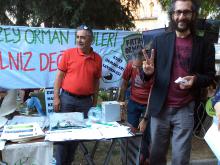Resistance Against Istanbul's Megaprojects

In the summer of 2013, popular resistance succeeded in stopping the demolition of Gezi Park, one of the last public green spaces in Istanbul. Yet development projects keep transforming the city at a dizzying pace.
Nearly every neighborhood in Istanbul today grapples with some new high-rise, luxury apartment complex, shopping mall, or freeway. Each of these projects fits in its own way within the Turkish government’s broader vision to transform Istanbul into a giant, glittering harbor of wealthy global elites.
In recent years, the ruling AK Party and its developers have turned their attention outside the city. Three integrated megaprojects—the Bosphorus Bridge, the Istanbul New Airport, and the Istanbul Canal—now threaten to decimate the last forested and agricultural areas surrounding Istanbul. The social and ecological consequences of these development projects promise to be devastating both within the city center and for the surrounding areas.
Ecologists, urban defense activists, and local villagers are working together to fight back through the Northern Forests Defense (NFD/ KOS). This diverse movement brings together those working to protect their living spaces against this coordinated onslaught of “creative destruction.” Founded in 2013 as part of the rising struggle after the Gezi Park resistance, NFD’s primary goal is to protect the diverse ecological zone extending from Lake Sapanca to the Strandzha Mountains (an area that consists of the last forests, watersheds, and farmlands outside Istanbul). They also promote a non-hierarchical framework, where human communities are considered to be an integral part of the natural world. Today, their focus is on stopping the megaprojects.
The Megaprojects
The Third Bosphorus Bridge, is already under construction. Spanning nearly 1,500 meters, this suspension bridge will soon be the 8th largest in the world.
Traffic from the third bridge will connect to another megaproject which is still in early stages of development—the Istanbul New Airport. This airport (Istanbul’s third) is planned to be the largest airport in the word. Construction will require 76.500.000 square meters of land, 80% of which is forested. 660 hectares of rare wetlands will also be destroyed, with important drinking water tributaries and ponds either destroyed or filled up with waste.
Yet both these projects pale in comparison to the government’s most recent scheme: the Istanbul Canal. This enormous man-made waterway would spread all the way from the Black Sea down to the Sea of Marmara—splitting Istanbul’s European side in two. The concept for this “second Bosphorus” was first developed by an Ottoman sultan nearly 500 years ago. Today, the Erdogan regime hopes to use it to commemorate the 500 year anniversary of the conquest of Istanbul.
These three main projects would lead to hundreds of other secondary projects-roads, shopping centers, parking lots, office high-rises and apartment blocks- and completely transform the ecological systems of the region. Such large-scale deforestation will accelerate the process of Istanbul becoming a “temperature island,” an urban bubble where heat has no means of escape. As activist Onur Akgül explained to me, “The average temperature in the city is already rising, and with the completion of projects, the city’s average temperature will be risen by 2 or 3 degrees in time. [Without the forests] Istanbul will become a real hell on earth.” Countless rural communities will also be destroyed. In this region, the economy is based primarily on herding animals. Without open grazing areas, villagers will have no choice but withdraw their animals, leave their homes, and migrate to the already overcrowded city.
Forging Urban and Rural Solidarity
On May 30th, 2015, Northern Forests Defense was invited to support a protest march at the proposed site of the third airport. This action was organized by a local collective based out of Yeniköy, one of the hundreds of villages directly under threat. With Northern Forests Defense coordinating participants from inside the city, the action drew over 100 individuals with an equal number from local villages and the city center. Although this growing campaign of rural and urban solidarity has no official name yet, activists at NDF are optimistic about the collaboration.
“This battle has to be fought by people in the city,” Akgül impressed; “This project [of urban transformation] has two feet that work together. Once you have dug the city down to its roots, you have to do something with the waste material that you yourself have dug.” In this way, the destructive developments which threaten life within the city are interlinked with the destructive megaprojects outside the city; not just ideologically, but also pragmatically.
Today, those who defend life within the city are becoming linked in solidarity with those who defend life outside it as well. Through groups such as Northern Forests Defense, resistance and solidarity is growing.